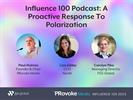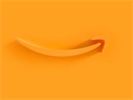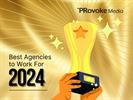Paul Holmes 31 Dec 2001 // 12:00AM GMT
Sunrise Technologies, a producer of high technology products that dramatically improve treatment methods in eye care, engaged BSMG Worldwide to coordinate special media events and activities to launch the Hyperion™ LTK System once Sunrise received market approval from the FDA. The Hyperion™ LTK System is a laser eye system that gently heats eye tissue outside the center of the cornea, thereby causing it to steepen and reduce farsightedness. To launch the new product, BSMG conceived and implemented an ongoing strategic media relations program that not only resulted in raising widespread awareness among the ophthalmology community, but also facilitated Sunrise Technologies’ penetration into local markets nationwide. The program was extremely successful because Sunrise’ revenues increased $426,000 for the six-months following the FDA’s approval of the Hyperion™ LTK System.
CHALLENGES
BSMG encountered several challenges leading up to and during the Hyperion™ launch, primarily revolving around FDA compliance issues. Among the most pressing obstacles:
“Temporary” Labeling: According to the FDA, the LTK procedure is for “temporary correction” of hyperopia. What “temporary correction” really meant in this case is that many LTK patients will gradually lose some of their correction over time (Unlike nearsightedness, the farsighted eye tends to keep changing over time). Because of the FDA’s “temporary” labeling, mixed messages appeared in the media (some reporters understood the labeling and were excited about the new procedure but some acted rather suspiciously). BSMG continued to educate reporters about what the labeling really meant and how it compares to other procedures, as no laser procedure is ever permanent as the body ages.
“Another Laser Eye Story”: Laser eye surgery stories have proliferated in the media during the past year and a half. Media outlets that have recently covered Lasik stories or another eye procedure prior to Sunrise receiving FDA approval are less inclined to do a story on LTK right away, despite their expressed interest in hearing from us upon FDA approval.
Timing: FDA approval arrived unexpectedly late and required Sunrise to launch its product on June 30, just prior to the Independence Day long weekend -- when it was difficult to reach medical producers and writers with whom BSMG had developed relationships. Because of the pending holiday, stories were "already in the can” and crews were short-staffed, so there was fewer attempts to follow the Sunrise story. We made all efforts to follow-up on Monday, July 3 and again on Wednesday, July 5, when we were able to reach more key national media.
OPPORTUNITIES
Lasik and other corrective procedures have created a “market” for laser technology. The LTK procedure is minimally invasive with little or no side effects and involves a shorter recovery time compared to other refractive correction procedures. Consumers can quickly and easily understand the benefits of LTK. Ophthalmologists can benefit financially by offering LTK to their patients because it can be offered in the office and can be learned quickly. These factors made for a compelling story to share with several types of media (e.g., medical and technology trade, consumer affairs, TV news, lifestyle magazines, etc.)
RESEARCH
BSMG discovered that Hyperopia – otherwise know as farsightedness – is the most common refractive error of the American population, with a total of about 77 million Americans affected (versus about 75 million Americans who are nearsighted). The number of Americans age 40 and over with hyperopia (about 60 million) is about twice as large as those with myopia (nearsightedness). About 40 million “hyperopes” are low to moderately farsighted in the range of +0.75 to +2.5 diopters (the measure of the focusing power of the eye). Hyperopes see poorly both near and far and often find themselves dependent on glasses/bifocals or contact lenses for the first time around the age of 40 when hyperopia often occurs, making it difficult to perform common sight-dependent functions like focusing on computer screens, applying makeup, cooking, or driving. This background information helped BSMG to identify Sunrise’ target audiences and develop appropriate communications.
STRATEGIC APPROACH
Objectives: BSMG’s overall objective was to generate awareness of and enthusiasm for a new type of minimally invasive laser eye technique while countering skepticism from the medical and FDA approval authorities. Specific objectives included:
Communicate the benefits of the Hyperion™ LTK System to target audiences;
Generate highly targeted media coverage in print and on key financial broadcast programs;
Establish awareness of the Hyperion™ LTK System among the general public;
Differentiate the LTK System from other refractive correction procedures
Target Audiences: Ophthalmologists, Optometrists, Eye Surgery Centers, Patients with hyperopia (40 and older) and media.
Essential Messages: 1) LTK is a safe, minimally invasive way to restore vision among hyperopes to near-perfect levels; 2) LTK’s ease-of-use features and cost effectiveness can help build a medical practice; and 3) LTK’s benefits are more compelling when compared to Lasik, PRK, Intacs and other refractive correction procedures.
Strategies: BSMG’s mantra was to be bold, communicate aggressively, and demonstrate clearly the benefits of LTK while igniting the interest of the media and other key audiences. Specific strategies included: 1) Showcasing the unique benefits of LTK over other more invasive procedures; 2) Linking LTK and Sunrise Technologies with recognized and respected third party organizations; 3) Positioning Sunrise Technologies as a leader in the field of refractive eye surgery; 4) Continuing to foster an ongoing dialog with the professional community; and 5) Breaking out of the pack to secure a share of voice.
CAMPAIGN EXECUTION
Within a half-hour of receiving the FDA approval on June 30, BSMG aggressively contacted targeted national and local media. BSMG then released a Video News Release (VNR) it had developed to further stimulate broadcast interest. Throughout the day, BSMG delivered press kits as needed to Los Angeles media. We also sent hard copies of b/roll/VNR to reporters on request.
BSMG continued to follow-up with all short-lead/trade media and arranged interviews with the Sunrise spokesperson and physicians on July 3. Due to the July 4 holiday, we continued to contact long-lead outlets on Wednesday, July 5.
BSMG coordinated a Webcast in September to spike additional consumer and physician awareness of the Sunrise LTK Procedure. This effort was preceded by aggressive media outreach two weeks prior to the Webcast. One week prior to the Webcast, our CyberPR division, along with InternetWire, began messaging outreach to chatrooms/newsgroups. One day prior to the Webcast, BSMG pushed the media advisory.
On the day of the Webcast, BSMG was able to place the Webcast on calendars for Discovery.com, Yahoo! And the Cornell Medical Center site (illustrating the prestige of the organizations with which Sunrise is affiliated) drawing more than 27,000 unique visitors to the pre-cast page just prior to the event.
RESULTS
Sunrise Technologies has received hundreds of millions of media impressions in media throughout the nation, including positive stories in New York Times, Los Angeles Times, Business Week, Boston Herald, The Washington Times, Atlanta Journal Constitution, Daily News Tribune, Newsday, Investor’s Business Daily, New York Daily News, among others.
The VNR received tens of millions of impressions over the months following FDA approval. The Webcast was so successful that viewers logging in for the live event literally overwhelmed the vendors server, forcing them to expand their systems to accommodate more than 27,000 users previewing the site and downloading the online press kit.
Within one month into the launch, 31 Hyperion™ LTK System was ordered, at approximately $200,000 each. Sunrise was already closing orders at a rate of more than one Hyperion™ LTK System per business day.
Revenues for the three and six-month periods ended June 30, 2000 were $424,000 and $442,000 respectively, compared to $3,000 and $16,000, respectively, for the same periods in 1999. This represents an increase of $421,000 in revenues for the three-months and $426,000 for the six-months ended June 30, 2000 as compared with 1999.
CHALLENGES
BSMG encountered several challenges leading up to and during the Hyperion™ launch, primarily revolving around FDA compliance issues. Among the most pressing obstacles:
“Temporary” Labeling: According to the FDA, the LTK procedure is for “temporary correction” of hyperopia. What “temporary correction” really meant in this case is that many LTK patients will gradually lose some of their correction over time (Unlike nearsightedness, the farsighted eye tends to keep changing over time). Because of the FDA’s “temporary” labeling, mixed messages appeared in the media (some reporters understood the labeling and were excited about the new procedure but some acted rather suspiciously). BSMG continued to educate reporters about what the labeling really meant and how it compares to other procedures, as no laser procedure is ever permanent as the body ages.
“Another Laser Eye Story”: Laser eye surgery stories have proliferated in the media during the past year and a half. Media outlets that have recently covered Lasik stories or another eye procedure prior to Sunrise receiving FDA approval are less inclined to do a story on LTK right away, despite their expressed interest in hearing from us upon FDA approval.
Timing: FDA approval arrived unexpectedly late and required Sunrise to launch its product on June 30, just prior to the Independence Day long weekend -- when it was difficult to reach medical producers and writers with whom BSMG had developed relationships. Because of the pending holiday, stories were "already in the can” and crews were short-staffed, so there was fewer attempts to follow the Sunrise story. We made all efforts to follow-up on Monday, July 3 and again on Wednesday, July 5, when we were able to reach more key national media.
OPPORTUNITIES
Lasik and other corrective procedures have created a “market” for laser technology. The LTK procedure is minimally invasive with little or no side effects and involves a shorter recovery time compared to other refractive correction procedures. Consumers can quickly and easily understand the benefits of LTK. Ophthalmologists can benefit financially by offering LTK to their patients because it can be offered in the office and can be learned quickly. These factors made for a compelling story to share with several types of media (e.g., medical and technology trade, consumer affairs, TV news, lifestyle magazines, etc.)
RESEARCH
BSMG discovered that Hyperopia – otherwise know as farsightedness – is the most common refractive error of the American population, with a total of about 77 million Americans affected (versus about 75 million Americans who are nearsighted). The number of Americans age 40 and over with hyperopia (about 60 million) is about twice as large as those with myopia (nearsightedness). About 40 million “hyperopes” are low to moderately farsighted in the range of +0.75 to +2.5 diopters (the measure of the focusing power of the eye). Hyperopes see poorly both near and far and often find themselves dependent on glasses/bifocals or contact lenses for the first time around the age of 40 when hyperopia often occurs, making it difficult to perform common sight-dependent functions like focusing on computer screens, applying makeup, cooking, or driving. This background information helped BSMG to identify Sunrise’ target audiences and develop appropriate communications.
STRATEGIC APPROACH
Objectives: BSMG’s overall objective was to generate awareness of and enthusiasm for a new type of minimally invasive laser eye technique while countering skepticism from the medical and FDA approval authorities. Specific objectives included:
Communicate the benefits of the Hyperion™ LTK System to target audiences;
Generate highly targeted media coverage in print and on key financial broadcast programs;
Establish awareness of the Hyperion™ LTK System among the general public;
Differentiate the LTK System from other refractive correction procedures
Target Audiences: Ophthalmologists, Optometrists, Eye Surgery Centers, Patients with hyperopia (40 and older) and media.
Essential Messages: 1) LTK is a safe, minimally invasive way to restore vision among hyperopes to near-perfect levels; 2) LTK’s ease-of-use features and cost effectiveness can help build a medical practice; and 3) LTK’s benefits are more compelling when compared to Lasik, PRK, Intacs and other refractive correction procedures.
Strategies: BSMG’s mantra was to be bold, communicate aggressively, and demonstrate clearly the benefits of LTK while igniting the interest of the media and other key audiences. Specific strategies included: 1) Showcasing the unique benefits of LTK over other more invasive procedures; 2) Linking LTK and Sunrise Technologies with recognized and respected third party organizations; 3) Positioning Sunrise Technologies as a leader in the field of refractive eye surgery; 4) Continuing to foster an ongoing dialog with the professional community; and 5) Breaking out of the pack to secure a share of voice.
CAMPAIGN EXECUTION
Within a half-hour of receiving the FDA approval on June 30, BSMG aggressively contacted targeted national and local media. BSMG then released a Video News Release (VNR) it had developed to further stimulate broadcast interest. Throughout the day, BSMG delivered press kits as needed to Los Angeles media. We also sent hard copies of b/roll/VNR to reporters on request.
BSMG continued to follow-up with all short-lead/trade media and arranged interviews with the Sunrise spokesperson and physicians on July 3. Due to the July 4 holiday, we continued to contact long-lead outlets on Wednesday, July 5.
BSMG coordinated a Webcast in September to spike additional consumer and physician awareness of the Sunrise LTK Procedure. This effort was preceded by aggressive media outreach two weeks prior to the Webcast. One week prior to the Webcast, our CyberPR division, along with InternetWire, began messaging outreach to chatrooms/newsgroups. One day prior to the Webcast, BSMG pushed the media advisory.
On the day of the Webcast, BSMG was able to place the Webcast on calendars for Discovery.com, Yahoo! And the Cornell Medical Center site (illustrating the prestige of the organizations with which Sunrise is affiliated) drawing more than 27,000 unique visitors to the pre-cast page just prior to the event.
RESULTS
Sunrise Technologies has received hundreds of millions of media impressions in media throughout the nation, including positive stories in New York Times, Los Angeles Times, Business Week, Boston Herald, The Washington Times, Atlanta Journal Constitution, Daily News Tribune, Newsday, Investor’s Business Daily, New York Daily News, among others.
The VNR received tens of millions of impressions over the months following FDA approval. The Webcast was so successful that viewers logging in for the live event literally overwhelmed the vendors server, forcing them to expand their systems to accommodate more than 27,000 users previewing the site and downloading the online press kit.
Within one month into the launch, 31 Hyperion™ LTK System was ordered, at approximately $200,000 each. Sunrise was already closing orders at a rate of more than one Hyperion™ LTK System per business day.
Revenues for the three and six-month periods ended June 30, 2000 were $424,000 and $442,000 respectively, compared to $3,000 and $16,000, respectively, for the same periods in 1999. This represents an increase of $421,000 in revenues for the three-months and $426,000 for the six-months ended June 30, 2000 as compared with 1999.
Article tags
Healthcare-Medical Devices


































.jpg)

















